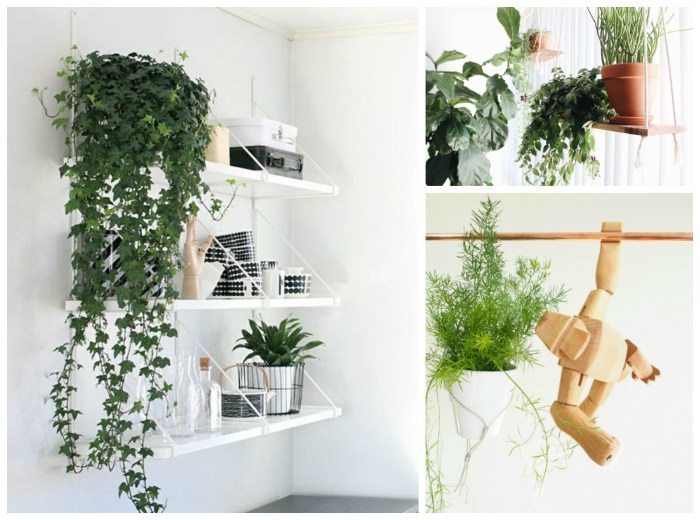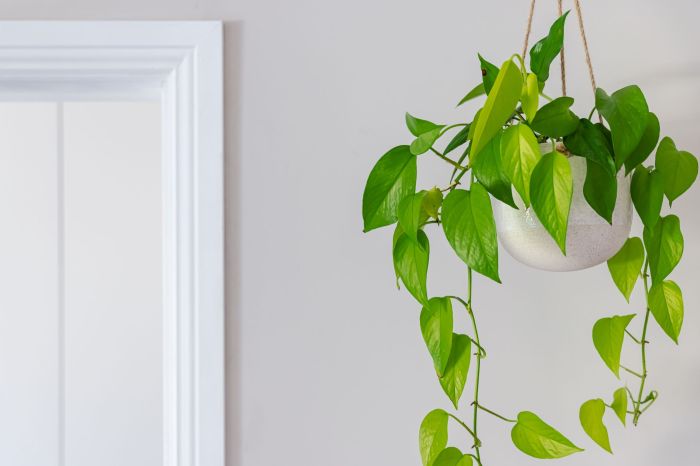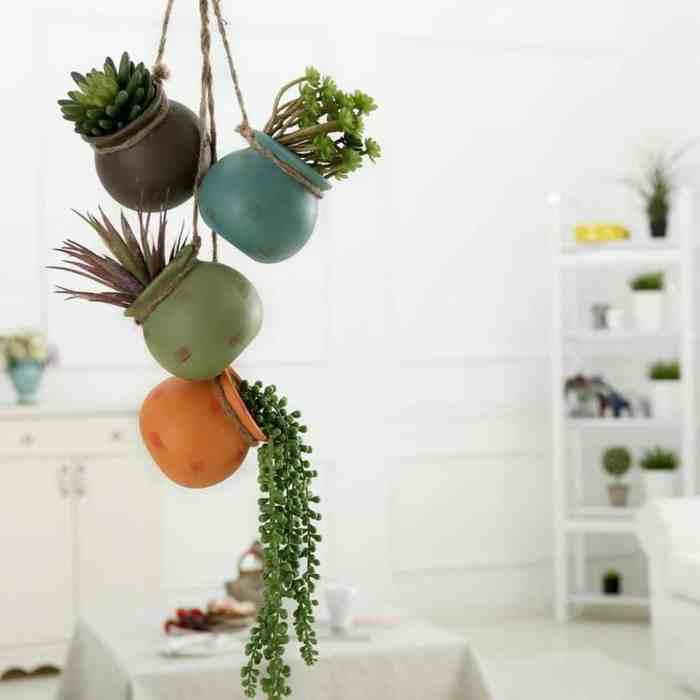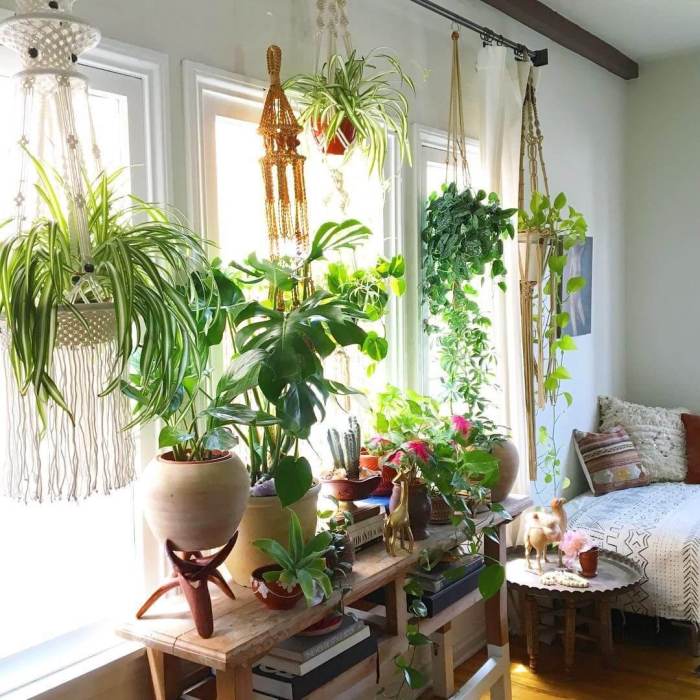In the realm of interior design, hanging plants have emerged as a captivating trend, transforming living spaces into vibrant oases. This comprehensive guide unveils the best way to hang indoor plants, empowering you to create a stunning indoor sanctuary that seamlessly blends nature and aesthetics.
From selecting the perfect hanging pots to determining optimal placement and providing proper care, this guide delves into the intricacies of hanging indoor plants, ensuring your verdant companions thrive and flourish in your home.
Techniques for Hanging Plants

Hanging plants can bring a touch of nature indoors and create a more inviting atmosphere. There are a variety of techniques you can use to hang plants, each with its own advantages and disadvantages.
Hooks
Hooks are a simple and inexpensive way to hang plants. They can be screwed into the ceiling or walls, and they can be used to hang plants of all sizes. However, hooks can be visible, which may not be desirable in all cases.
The best way to hang indoor plants is to use a hook or bracket that is attached to the ceiling or wall. This will keep the plant out of the way of foot traffic and will allow it to receive plenty of sunlight.
For bedrooms, hanging plants can add a touch of elegance and can help to purify the air. When hanging plants indoors, it is important to choose a pot that is the right size and weight for the plant. The pot should also have drainage holes to prevent the plant from becoming waterlogged.
Nails
Nails are another option for hanging plants. They are less visible than hooks, but they are not as strong. Nails can also damage the walls or ceiling if they are not installed properly.
Brackets
Brackets are a more permanent solution for hanging plants. They are typically made of metal or wood, and they can be mounted on the ceiling or walls. Brackets are more visible than hooks or nails, but they are also more secure.
Creative Ideas
There are a number of creative ways to hang plants from the ceiling or walls. You can use macrame hangers, wire baskets, or even old picture frames. These methods can add a unique touch to your home decor.
Choosing the Right Hanging Pots

When selecting hanging pots, consider the following factors:
Material
The material of the hanging pot can affect its durability, weight, and aesthetic appeal. Common materials include:
- Ceramic: Durable and stylish, but heavy and can break easily.
- Plastic: Lightweight and inexpensive, but may not be as durable.
- Metal: Durable and lightweight, but can rust if not properly treated.
- Wicker: Natural and lightweight, but may require additional protection from the elements.
Size
The size of the hanging pot should be appropriate for the size of the plant and the space available. Consider the plant’s root system and future growth when selecting the pot size.
Drainage
Proper drainage is crucial for the health of your plants. Choose hanging pots with drainage holes to allow excess water to drain away. If the pot does not have drainage holes, you can create them yourself or use a liner with holes.
Aesthetic Considerations
The hanging pot should complement the plant and the home décor. Consider the color, shape, and texture of the pot when making your selection.
Recommendations, Best way to hang indoor plants
For small trailing plants, such as ivy or spider plants, a small ceramic or plastic hanging pot is suitable.For larger plants, such as ferns or philodendrons, a larger metal or wicker hanging pot may be necessary.
Placement and Lighting: Best Way To Hang Indoor Plants

Positioning your hanging plants strategically is crucial for their health and aesthetics. Consider the light requirements of each plant species when choosing their location.
Natural light is ideal, so place plants near windows that receive bright, indirect light. Avoid direct sunlight, as it can scorch leaves. If natural light is limited, consider using artificial grow lights to supplement.
Artificial Light Sources
Artificial light sources, such as LED grow lights, can provide the necessary light for plants in areas with limited natural light. These lights emit specific wavelengths that promote plant growth and flowering. Choose grow lights with adjustable intensity and spectrum to tailor them to the needs of different plant species.
Care and Maintenance
Maintaining the health and beauty of hanging plants requires specific care and maintenance practices. These plants thrive in environments that mimic their natural habitats, necessitating attention to watering, fertilizing, pest control, pruning, and repotting.
Proper watering is crucial, as hanging plants are prone to drying out quickly due to their elevated position. Water the soil thoroughly until excess water drains from the drainage holes, allowing the soil to dry out slightly before watering again.
Avoid overwatering, as it can lead to root rot.
Hanging indoor plants is a great way to add life and style to your home. But with so many different ways to hang plants, it can be hard to know where to start. That’s why we’ve put together a guide to the best way to hang indoor plants, including tips on choosing the right plants, pots, and hangers.
We’ve also included a list of the best house plants hanging, so you can find the perfect plants for your home. For more information on choosing the best house plants hanging, visit best house plants hanging .
Fertilizing
Fertilize hanging plants regularly during the growing season, typically from spring to fall. Use a balanced liquid fertilizer diluted to half strength and apply it to the soil according to the manufacturer’s instructions. Avoid overfertilizing, as it can damage the plant.
Pest Control
Hanging plants are susceptible to pests such as aphids, mealybugs, and spider mites. Regularly inspect plants for signs of infestation and treat them promptly with appropriate pesticides or insecticidal soap. Isolate infected plants to prevent the spread of pests.
Pruning and Repotting
Regular pruning helps maintain the shape and size of hanging plants. Remove dead or damaged leaves and stems, and trim overgrown shoots to encourage bushier growth. Repot hanging plants when they become rootbound or when the soil becomes depleted. Use a well-draining potting mix and a pot that is slightly larger than the previous one.
Decorative Applications

Hanging plants are not just functional but also aesthetically pleasing, offering endless possibilities for enhancing the ambiance of any space.
Beyond their practical benefits, hanging plants can transform ordinary rooms into vibrant oases, adding a touch of nature and creating a sense of tranquility.
Vertical Gardening and Living Walls
Hanging plants play a crucial role in vertical gardening, where they are suspended on walls or trellises to create stunning living walls. These vertical displays not only save space but also bring the outdoors indoors, creating a lush and inviting atmosphere.
The art of hanging indoor plants requires careful consideration of various factors, including the type of plant and the appropriate hanging method. For those seeking the best trailing plants for hanging baskets, there are numerous options to explore. From the elegant best trailing plant for hanging basket to the cascading vines, these plants add a touch of greenery and visual interest to any space.
By choosing the right plant and utilizing proper hanging techniques, homeowners can create a thriving indoor garden that brings nature’s beauty into their homes.
Hanging Plant Displays for Special Occasions
Hanging plants can elevate any special occasion or event, adding a touch of elegance and sophistication. For weddings, they can be suspended from the ceiling to create a romantic and ethereal ambiance. At parties, they can be used to decorate outdoor spaces, providing a festive and welcoming touch.
Final Review
Hanging indoor plants not only enhances the visual appeal of your space but also brings a touch of nature indoors, fostering a sense of tranquility and well-being. By following the expert advice Artikeld in this guide, you can create a thriving indoor ecosystem that will bring joy and beauty to your home for years to come.
Questions Often Asked
What are the most suitable hanging pots for indoor plants?
When selecting hanging pots, consider factors such as material (e.g., ceramic, plastic, metal), size (to accommodate the plant’s root system), and drainage (to prevent waterlogging).
How do I determine the best placement for my hanging plants?
Evaluate the light requirements of your plants and choose a location that provides adequate natural or artificial light. Consider the overall aesthetics and how the hanging plants will complement the existing décor.
What are the specific care needs of hanging plants?
Hanging plants require regular watering, fertilizing, and pest control. Prune and repot them as needed to maintain their health and appearance.